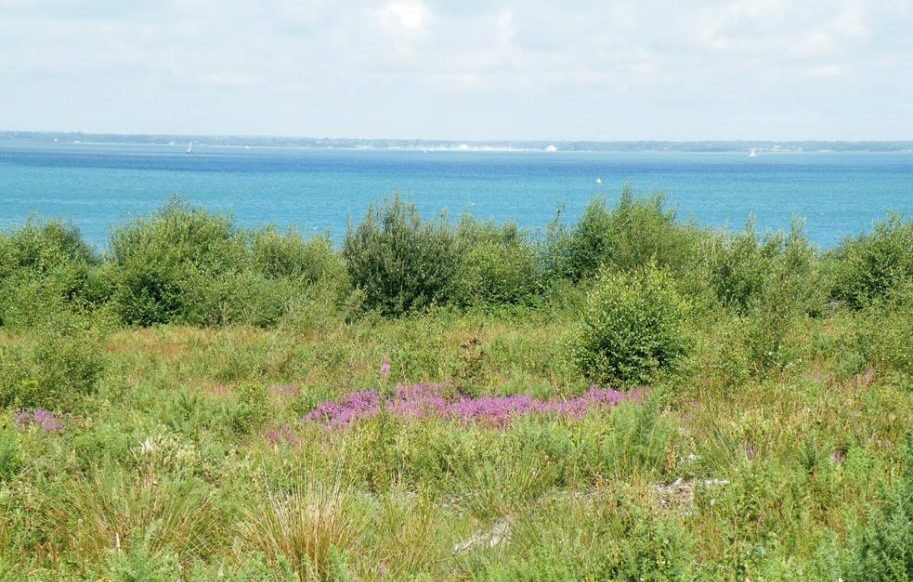 Back in the middle ages on the Isle of Wight, heathland – an open landscape dominated by heather, gorse and birch – was common as sheep grazed the northern plains and downland. The economy of the Island was heavily dependent on the wool trade but when this declined, the heathlands declined too.
Back in the middle ages on the Isle of Wight, heathland – an open landscape dominated by heather, gorse and birch – was common as sheep grazed the northern plains and downland. The economy of the Island was heavily dependent on the wool trade but when this declined, the heathlands declined too.
Increasing industrialisation led to a decline in the pastoral economy with many leaving the Island to seek their fortune in the new cities. The decline in heathland continued with the rapid advances in farming technologies led to the improvement of soils for growing grass. Further declines were brought about by the planting of trees in the mid-20th century at Parkhurst, Bouldnor and Firestone. So by 1850, 82{a9dddf1bd2af35332cd5613cac8e63e148b38f23ebed35c9943c32a7f65a9815} of heathland habitat had been lost from the Island and by 2000 it had dwindled to a total of 66ha (163 acres). Most of this was found on National Trust land at Headon Warren and Luccombe.
Heathland is an important habitat which is rare in northern Europe but common in some southern counties such as Hampshire, Surrey and Sussex. It contains beautiful creatures such as Dartford Warbler, Nightjar, Woodlark, Emperor Moth, Silver-studded Blue Butterfly and Sand Lizard which are all nationally rare but sadly many are not found on the Island.
In 2008, the Hampshire and Isle of Wight Wildlife Trust, the Forestry Commission and the National Trust formed a partnership and decided to undertake a heathland restoration programme in four sites on the Island. Ningwood Common, Mottistone Down, Bouldnor Forest and Brighstone Forest were chosen to receive funding from the West Wight Landscape Partnership to return these areas to heathland. If successful it would increase the total area of this habitat on the Island to over 100 ha (250 acres).
Bouldnor Forest was chosen because it had only been planted in the 1950’s and since then had not been subjected to any other agricultural improvement, that is no herbicides, fertilisers or pesticides had been used for sixty years. In the winter of 2009, the Forestry Commission felled the conifers from a 9 ha (22 acres) site in front of the old Bouldnor Battery gun emplacement. The Wildlife Trust then commissioned a fence to be placed on one side of the felled area so that the site could be grazed and in the spring of 2011, thirty Hebridean sheep (on loan from the National Trust) were introduced onto the area. Sheep grazing had returned after six decades to the heathland at Bouldnor.
 Not content with the restoration of the heathland, three ponds were also constructed within the area to add habitat and landscape diversity. These ponds were built to add to existing ponds in the Forest which were getting shaded and give the wetland wildlife of the forest new opportunities to expand their range.
Not content with the restoration of the heathland, three ponds were also constructed within the area to add habitat and landscape diversity. These ponds were built to add to existing ponds in the Forest which were getting shaded and give the wetland wildlife of the forest new opportunities to expand their range.
This management has brought about a landscape-scale change to the north-west Wight. Spectacular views have been restored but also heathland wildlife has returned. As well as characteristic heathland plants such as Bell Heather, Common Heather, Tormentil, Wood Sage and Dwarf Gorse, four scarce plants have been found including Pale Violet, Heath Dog Violet, Dodder and Cyperus Sedge. Nightjars and Ravens now breed here and Hobbys can regularly be seen flying over the site. Dark green Fritillary Butterflies and a bewildering array of dragonflies, butterflies, grasshoppers and moths have taken up residence. None of these species were found here before under the deep shade cast by the coniferous trees planted in the last century.
Access to the new heathland at Bouldnor is easy with the coastal path between Yarmouth and Cranmore following a route along the whole site. An education pack and walks leaflet have been produced to help school children, residents and visitors find out more about their heathland heritage.
All this work has to be sustainable if these habitats are to reach their potential as havens for heathland wildlife. So in 2011 the Wildlife Trust negotiated the creation of a new nature reserve to cover the newly restored heathland. This new reserve is also the home of the Wildlife Trust’s operation on the Island establishing an office and education centre. From here the Wildlife Trust can not only look after the new heathland and ponds on site, it has access to the other new heathland sites on the West Wight.
This 30{a9dddf1bd2af35332cd5613cac8e63e148b38f23ebed35c9943c32a7f65a9815} increase in an internationally scarce habitat is a testament to the hard work of organisations working together, in partnership, to achieve outstanding results for our Island’s natural heritage.



